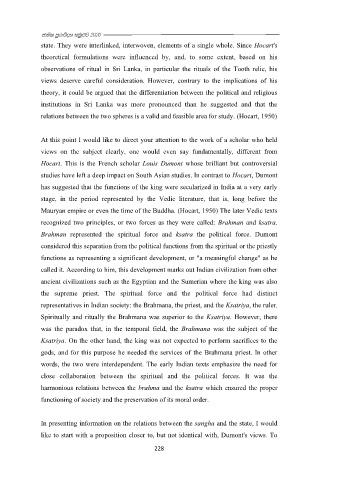Page 249 - Proceedings book
P. 249
q
cd;sl mqrdúoHd iu¿j 2025
state. They were interlinked, interwoven, elements of a single whole. Since Hocart's
theoretical formulations were influenced by, and, to some extent, based on his
observations of ritual in Sri Lanka, in particular the rituals of the Tooth relic, his
views deserve careful consideration. However, contrary to the implications of his
theory, it could be argued that the differentiation between the political and religious
institutions in Sri Lanka was more pronounced than he suggested and that the
relations between the two spheres is a valid and feasible area for study. (Hocart, 1950)
At this point I would like to direct your attention to the work of a scholar who held
views on the subject clearly, one would even say fundamentally, different from
Hocart. This is the French scholar Louis Dumont whose brilliant but controversial
studies have left a deep impact on South Asian studies. In contrast to Hocart, Dumont
has suggested that the functions of the king were secularized in India at a very early
stage, in the period represented by the Vedic literature, that is, long before the
Mauryan empire or even the time of the Buddha. (Hocart, 1950) The later Vedic texts
recognized two principles, or two forces as they were called: Brahman and ksatra.
Brahman represented the spiritual force and ksatra the political force. Dumont
considered this separation from the political functions from the spiritual or the priestly
functions as representing a significant development, or "a meaningful change" as he
called it. According to him, this development marks out Indian civilization from other
ancient civilizations such as the Egyptian and the Sumerian where the king was also
the supreme priest. The spiritual force and the political force had distinct
representatives in Indian society: the Brahmana, the priest, and the Ksatriya, the ruler.
Spiritually and ritually the Brahmana was superior to the Ksatriya. However, there
was the paradox that, in the temporal field, the Brahmana was the subject of the
Ksatriya. On the other hand, the king was not expected to perform sacrifices to the
gods, and for this purpose he needed the services of the Brahmana priest. In other
words, the two were interdependent. The early Indian texts emphasize the need for
close collaboration between the spiritual and the political forces. It was the
harmonious relations between the brahma and the ksatra which ensured the proper
functioning of society and the preservation of its moral order.
In presenting information on the relations between the sangha and the state, I would
like to start with a proposition closer to, but not identical with, Dumont's views. To
228

